
German postcard by Verlag Hermann Leiser, Berlin-Wilm., no. 1202, 1910s. Photo: Atelier Lendvai-Dircksen.

German postcard by Ross Verlag, Berlin, no. 1629/1. Photo: Nero-Film, Berlin. Was ist los im Zirkus Beely?/The Phantom of the Circus (Harry Piel, 1927) was Harry Piel's 75th film. It was the first Harry Piel film with a full-grown predator as Piel's companion: the tiger Bylard from the Leipzig Zoo. Mathias Bleckmann in his 1992 biography of Piel tells a nice anecdote. To the admiration of the wrangler present, Piel calmly managed to have the animal adapt to the camera. In order to have the tiger lick his face as the script demanded, he smeared his own mouth with cheese, but he had forgotten that a tiger's tongue might be sharp as a blade - so he ended up a few days in hospital...

German postcard by Ross Verlag, no. 1172/1, 1927-1928. Photo: publicity still for the German-French co-production Zigano (Harry Piel, Gerard Bourgeois, 1925), for which the exteriors were shot in Rome.

German postcard by Ross Verlag, Berlin, no. 1785/2, 1927-1928. Photo: Phoebus-Film. Harry Piel in Achtung Harry! Augen auf!/Neck or Nothing (Harry Piel, 1926).
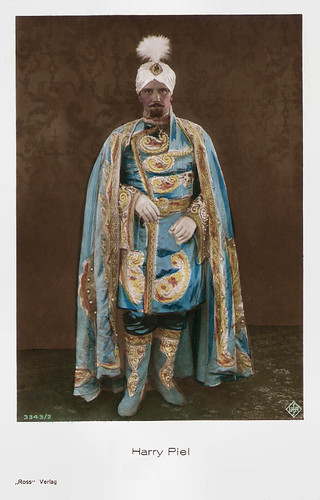
German postcard by Ross Verlag, no. 3343/2, 1928-1929. Photo: Ufa. Publicity still for Panik/Panic (Harry Piel, 1928), in which Piel plays Mister X, alias Harry Peel, alias The Rajah of Lahore.

German postcard by Ross Verlag, Berlin, no. 4317/1, 1929-1930. Photo: Ariel-Film, Berlin.
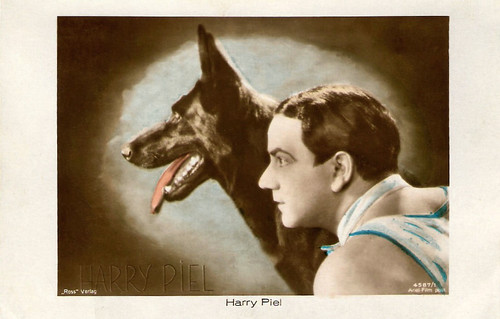
German postcard by Ross Verlag, Berlin, no. 4587/1, 1929-1930. Photo: Ariel-Film. Piel worked for Ariel-Film GmbH from 1928 to 1938. Publicity still for Sein bester Freund/His Best Friend (Harry Piel, 1929).
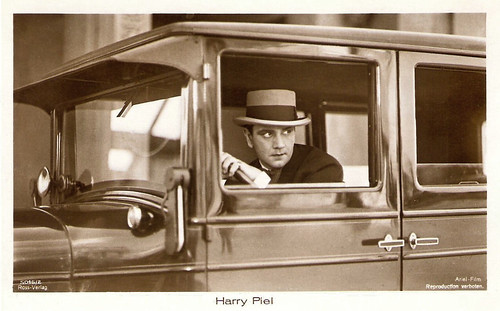
German postcard by Ross Verlag, no. 5046/2, 1930-1931. Photo: Ariel-Film. In 1930, Harry Piel produced and directed Achtung! Auto-Diebe!/Attention! Car Thieves! (Harry Piel, 1930). It was his last silent film.
The dynamite director
Hubert August Piel was born in Düsseldorf, Germany in 1892, as the son of an innkeeper and a farmer's daughter.
His career started already adventurous. After attending elementary school in Benrath and secondary school in Düsseldorf, Piel became a cadet in 1909 on a sail training ship, the Grand Duchess Elizabeth, but seven months later, he was sent back home because of heart failure. He started a commercial apprenticeship, did some odd jobs including working in a circus, and studied several foreign languages. In 1911 he went to Paris to become a stunt pilot.
In France, he met director Léonce Perret, who introduced him to Gaumont. There he wrote his first script and the cinema became his passion. In 1912 he moved to Berlin where he founded his first film company, the Kunst-Film-Verlags-GmbH. His debut as a director-writer-producer was the adventure film Schwarzes Blut/Black Blood (Harry Piel, 1912) starring Curt Goetz. Even though his company went bankrupt, Piel had become established.
In the following years, he shot dozens of short films full of action and adventure such as Der Triumph des Todes/The Triumph of the Death (Harry Piel, 1912), Ein Millionenraub/A Million Robbery (Harry Piel, 1914), and Die grosse Wette/The Large Bet (Harry Piel, 1916), all starring Ludwig Trautmann.
As a director, he had the nickname ‘the dynamite director’ because of all the exploding bridges and houses in his films. These explosions were often authentic. A demolition engineer notified him about forthcoming blow-ups. He filmed the explosions and inserted the footage into his films.
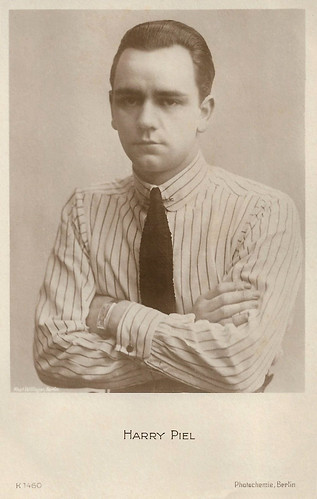
German postcard by Photochemie, Berlin, no. K. 1460. Photo: Willinger.
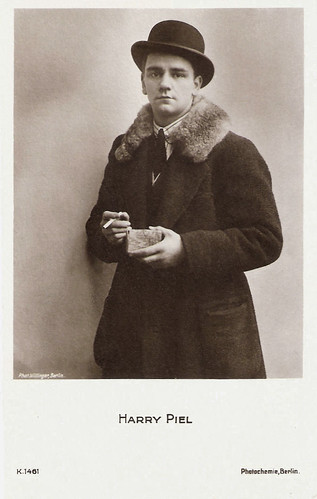
German postcard by Photochemie, Berlin, no. K. 1481. Photo: Willinger, Berlin.
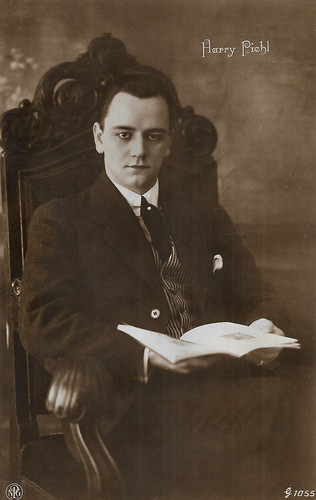
German postcard by NPG, no. G 1055. Sent by mail in 1917.
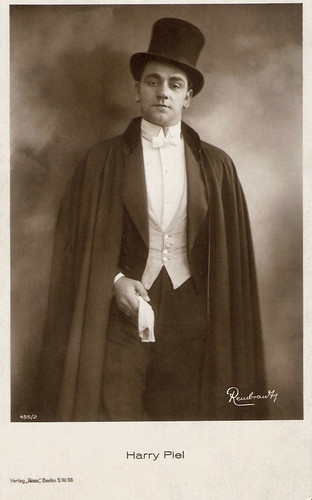
German postcard by Ross Verlag, Berlin, no. 455/2, 1919-1924. Photo: Rembrandt.
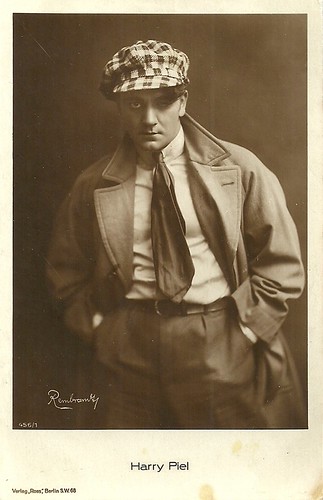
German postcard by Ross Verlag, Berlin, no. 456/1, 1919-1924. Photo: Rembrandt.

German postcard by Ross Verlag, Berlin, no. 456/2, 1919-1924. Photo: Rembrandt. Harry Piel in his own production Der Fürst der Berge/The King of the Mountains (1921), shot in Holland, Spain, Morocco and Rüdensdorfer Heinitzsee.
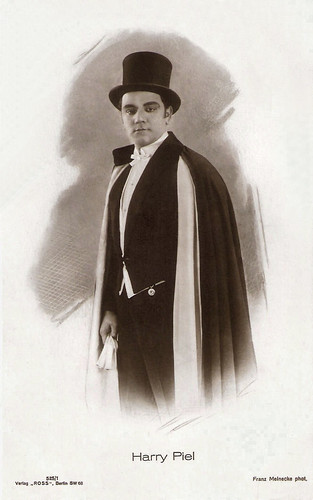
German postcard by Ross Verlag, Berlin, no. 525/1, 1919-1924. Photo: Franz Meinecke, Berlin.
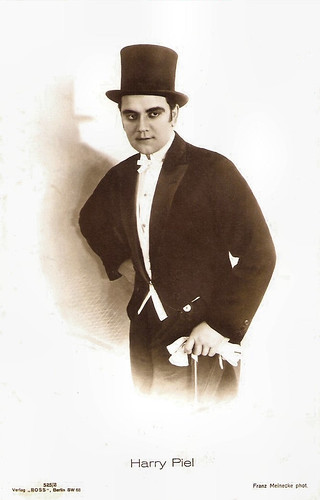
German postcard by Ross Verlag, Berlin, no. 525/2, 1919-1924. Photo: Franz Meinecke, Berlin.
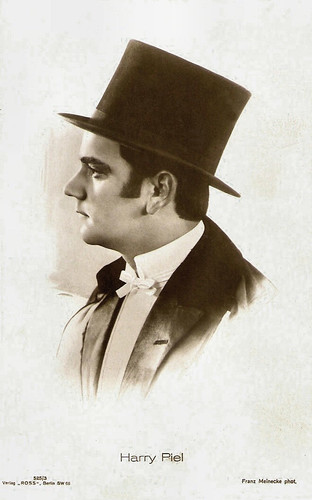
German postcard by Ross Verlag, Berlin, no. 525/3, 1919-1924. Photo: Franz Meinecke, Berlin.
Joe Deebs, Private Investigator
In 1915, Harry Piel became too bored with just standing behind the lens and he started to act before the camera. His first film as a leading actor, Die große Wette/The Large Bet (Harry Piel, 1916), was a Science-Fiction film on the subject of man-machines.
In Unter heißer Zone/Under the Hot Sun (Harry Piel, 1916) he used scenes with wild animals for the first time. He pretended that he did all his stunts himself, but the most dangerous stunts were carried out by Hermann Stetza.
During 1918 and 1919, Piel directed and starred in eight films of the Joe Deebs, private investigator series. Internationally he became a popular film star under the name of Harry Peel. Sadly not many of the films of his best period - the 1920s - have survived: 72 negatives of his films, including nearly all his silent pictures, perished in a WWII air raid.
David Cairns in his Notebook: "One that can still be seen is his circus mystery, Was ist Los im Zirkus Beely? (1927), in which Harry is falsely accused of murder and must uncover chicanery at a huge circus—not a travelling one, a permanent one, a mighty big top of the stone. Piel gets a lot of exciting use out of this edifice, rather like the way Buster Keaton would exploit the structural qualities of a locomotive or ocean liner. Most of the film is set here, as Harry evades capture by the stalwart Inspector Bull and hunts the three villains, a vixenish vamp, a hulking henchman and a masked man of mystery. The latter is authentically alarming, his mask a good deal scarier than Michael Myers' melted Shatner visage."
In 1927 he also starred in a double role alongside Marlene Dietrich in Sein größter Bluff/His Greatest Bluff (Henrik Galeen, Harry Piel, 1927). That same year he married actress Dary Holm, who appeared in several of his films.

German postcard by Ross Verlag, Berlin, no. 1099/1, 1927-1928. Photo: Binder / Ariel-Film.

German postcard by Ross Verlag, Berlin, no. 1172/2, 1927-28. Photo: still for Zigano (Harry Piel, Gérard Bourgeois, 1925).

German postcard by Ross Verlag, Berlin, no. 1173/2, 1927-28. Photo: still for Zigano (Harry Piel, Gérard Bourgeois, 1925).

German postcard by Ross Verlag, Berlin, no. 1295/1, 1927-1928. Photo: Atelier Bernhardt, Berlin.
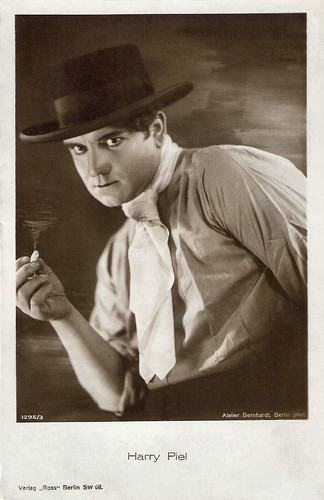
German postcard by Ross Verlag, Berlin, no. 1295/3, 1927-1928. Photo: Atelier Bernhardt, Berlin.
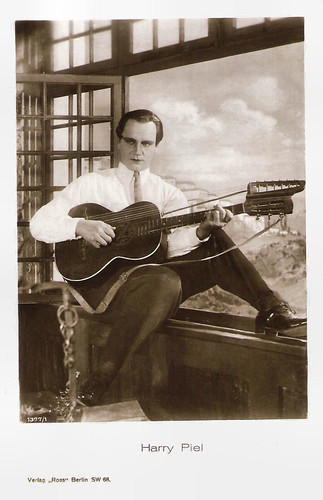
German postcard by Ross Verlag, Berlin, no. 1377/1, 1927-1928.

German postcard by Ross Verlag, Berlin, no. 1377/2, 1927-1928.

German postcard by Ross Verlag, Berlin, no. 1377/4, 1927-1928.

German postcard by Ross Verlag, Berlin, no. 1629/1, 1927-1928. Photo: Nero-Film, Berlin. Publicity still for Was ist los im Zirkus Beely?/The Phantom of the Circus (Harry Piel, 1927).

German postcard by Ross Verlag, Berlin, no. 1885/1, 1927-1928. Photo: Phoebus-Film. Harry Piel in Achtung Harry! Augen auf!/Neck or Nothing (Harry Piel, 1926).
Doppelganger
Effortlessly Harry Piel changed to sound film in the doppelganger comedy Er oder ich/Him or Me (Harry Piel, 1930) with Valerie Boothby.
Many adventure films followed, such as the box-office hits Schatten der Unterwelt/Shade of the Underworld (Harry Piel, 1931) with Elisabeth Pinajeff, Jonny stiehlt Europa/Johnny Steals Europe (Andrew Marton, Harry Piel, 1932) with Alfred Abel, and Der Dschungel ruft/The Call of the Jungle (Harry Piel, 1935) with Gerda Maurus.
Difficulties began with Panik/Panic (Harry Piel, 1940-1943), about an animal catcher who works for German zoos. At the film's climax, an air raid on a German city frees the wild animals in the zoo and only the heroic trapper can recapture them. The authorities found the air strikes too realistic and did not want the public to believe that Germany was in danger, so the film was forbidden.
Furthermore, his production company, Ariel Film Co., was liquidated through the nationalisation and 72 negatives of his films, nearly all silent films, were destroyed with an air strike. He was a sustaining member of the NSDAP (the Nazi party), and after the war he first concealed this to his enquirers. He was sentenced to six months of detention and five years of professional disqualification.
After his denazification in 1950, he refounded Ariel Film. His last directorial effort was Gesprengte Gitter/Elephant Fury (Harry Piel, 1953) with Dorothea Wieck, which was based on Panik. However, it had only moderate success. Piel gave up Ariel-film in 1960 and retired. Harry Piel died in Munich, Germany in 1963.
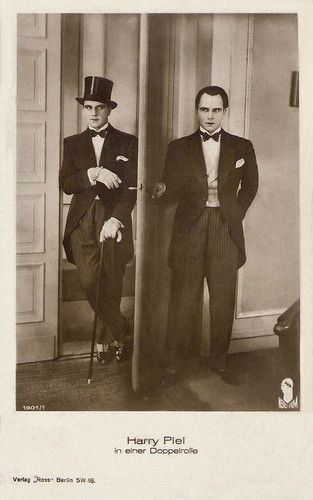
German postcard by Ross Verlag, Berlin, no. 1901/1, 1927-1928. Photo: Nero Film. Piel played twin brothers in Sein grösster Bluff/His Greatest Bluff (Harry Piel, 1927).

German postcard by Ross Verlag, Berlin, no. 1901/2, 1927-1928. Photo: Nero-Film.

German postcard by Ross Verlag, Berlin, no. 3343/1, 1928-1929. Photo: Ufa. Publicity still for Panik/Panic (Harry Piel, 1928).

German postcard by Ross Verlag, Berlin, no. 3567/1, 1928-1929. Photo: Ufa.

German postcard by Ross Verlag, Berlin, no. 4654/1, 1929-1930. Photo: Ariel-Film, Berlin. Publicity still for Sein bester Freund (Harry Piel, 1930).

German postcard by Ross Verlag, Berlin, no. 4654/2, 1929-1930. Photo: Ariel-Film. Mailed in Riga, Latvia, in 1930.
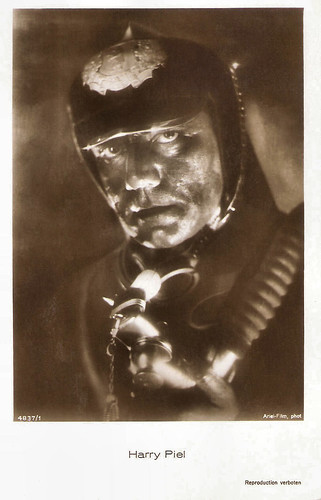
German postcard by Ross Verlag, Berlin, no. 4837/1, 1929-1930. Photo: Ariel-Film. Publicity still for Menschen im Feuer (Harry Piel, 1930).

German postcard by Ross Verlag, Berlin, no. 5179/2, 1930-1931. Photo: Ariel-Film, Berlin. Publicity still for Er oder ich/He or I (Harry Piel, 1930).
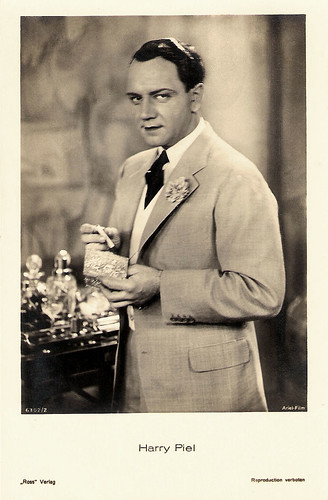
German postcard by Ross Verlag, no. 6302/2, 1931-1932. Photo: Ariel-Film.

German postcard. Photo: Ariel-Film / Siegel-Monopol.
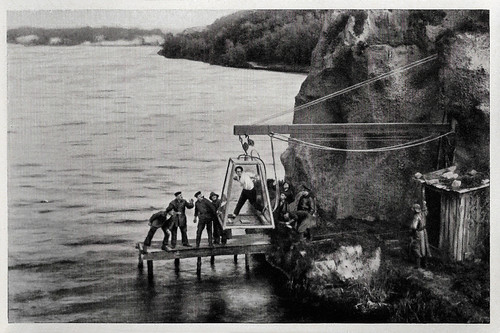
German collectors card by Ross Verlag in the series Vom Werden deutscher Filmkunst - Der Stumme Film, album no. 43, picture no. 126. Photo: Harry Piel-Film. Publicity still for Rivalen/Rivals (Harry Piel, 1923).

German collectors card by Ross Verlag in the series 'Vom Werden deutscher Filmkunst - Der stumme Film', album no. 42, picture no. 127. Photo: Ufa. Harry Piel and Dary Holm in Panik/Panic (Harry Piel, 1928).

German collectors card in the series 'Vom Werden deutscher Filmkunst - Der Tonfilm', album no. 11, picture no. 90. Photo: Ariel-Film / Ross Verlag. Fritz Odemar and Harry Piel in Ein Unsichtbarer geht durch die Stadt/An Invisible Man Goes Through the City (Harry Piel, 1934).

German postcard by "Das Programm von Heute" für Film und Theater GmbH / Ross Verlag. Photo: Ariel-Europa. Probably for the film Der Dschungel ruft/The Call of the Jungle (Harry Piel, 1936).
Sources: David Cairns (Notebook), Thomas Staedeli (Cyranos), Stephanie D'heil (Steffi-Line) (German), Wikipedia, Filmportal.de and IMDb.
No comments:
Post a Comment